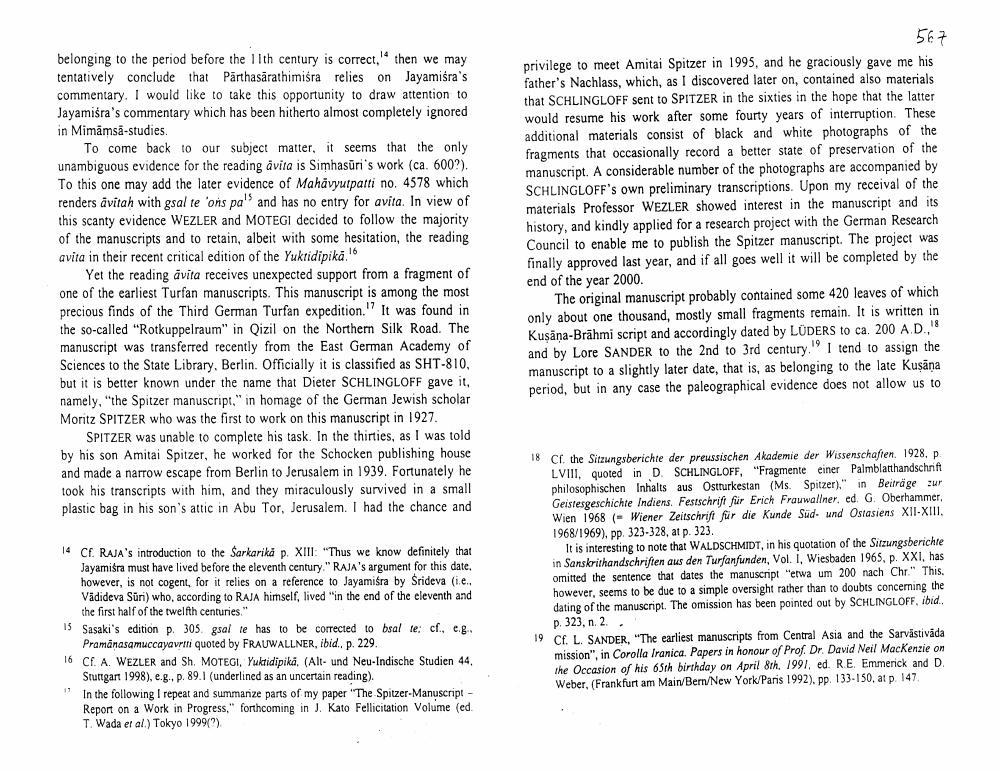Book Title: Avita And Avita Author(s): Eli Franco Publisher: Eli Franco View full book textPage 3
________________ belonging to the period before the 11th century is correct, then we may tentatively conclude that Pārthasarathimišra relies on Jayamisra's commentary. I would like to take this opportunity to draw attention to Jayamišra's commentary which has been hitherto almost completely ignored in Mimāmsã-studies. To come back to our subject matter, it seems that the only unambiguous evidence for the reading a vita is Simhasüri's work (ca. 600?). To this one may add the later evidence of Mahävyutpatti no. 4578 which renders avitah with gsal te 'ons pa' and has no entry for avita. In view of this scanty evidence WEZLER and MOTEGI decided to follow the majority of the manuscripts and to retain, albeit with some hesitation, the reading avita in their recent critical edition of the Yukridipika. Yet the reading a vita receives unexpected support from a fragment of one of the earliest Turfan manuscripts. This manuscript is among the most precious finds of the Third German Turfan expedition. It was found in the so-called "Rotkuppelraum" in Qizil on the Northern Silk Road. The manuscript was transferred recently from the East German Academy of Sciences to the State Library, Berlin. Officially it is classified as SHT-810, but it is better known under the name that Dieter SCHLINGLOFF gave it, namely, the Spitzer manuscript." in homage of the German Jewish scholar Moritz SPITZER who was the first to work on this manuscript in 1927. SPITZER was unable to complete his task. In the thirties, as I was told by his son Amitai Spitzer, he worked for the Schocken publishing house and made a narrow escape from Berlin to Jerusalem in 1939. Fortunately he took his transcripts with him, and they miraculously survived in a small plastic bag in his son's attic in Abu Tor, Jerusalem. I had the chance and 567 privilege to meet Amitai Spitzer in 1995, and he graciously gave me his father's Nachlass, which, as I discovered later on, contained also materials that SCHLINGLOFF sent to SPITZER in the sixties in the hope that the latter would resume his work after some fourty years of interruption. These additional materials consist of black and white photographs of the fragments that occasionally record a better state of preservation of the manuscript. A considerable number of the photographs are accompanied by SCHLINGLOFF's own preliminary transcriptions. Upon my receival of the materials Professor WEZLER showed interest in the manuscript and its history, and kindly applied for a research project with the German Research Council to enable me to publish the Spitzer manuscript. The project was finally approved last year, and if all goes well it will be completed by the end of the year 2000. The original manuscript probably contained some 420 leaves of which only about one thousand, mostly small fragments remain. It is written in Kusana-Brähmi script and accordingly dated by LÜDERS to ca. 200 AD." and by Lore SANDER to the 2nd to 3rd century." I tend to assign the manuscript to a slightly later date, that is, as belonging to the late Kusana period, but in any case the paleographical evidence does not allow us to 14 Cf. RAJA's introduction to the Sarkarika p. XIII: "Thus we know definitely that Jayamira must have lived before the eleventh century. " RAJA's argument for this date. however, is not cogent, for it relies on a reference to Jayamira by Srideva (ie. Vädideva Sür) who, according to RAJA himself, lived in the end of the eleventh and the first half of the twelfth centuries." 15 Sasaki's edition p. 305 gsal te has to be corrected to bsal te: cf. c.g. Pramanasamuccayavrtti quoted by FRAUWALLNER, ibid., p. 229. 16 Cf. A. WEZLER and Sh. MOTEGI, Yuktidipikä. (Alt- und Neu-Indische Studien 44 Stuttgart 1998), e.g. p. 89.1 (underlined as an uncertain reading) In the following I repeat and summarize parts of my paper "The Spitzer-Manuscript - Report on a Work in Progress," forthcoming in J. Kato Fellicitation Volume (ed. T. Wada et al.) Tokyo 1999?). 18 Cf the Sitzungsberichte der preussischen Akademie der Wissenschaften. 1928. P LVIII, quoted in D. SCHLINGLOFF, "Fragmente einer Palmblatthandschrift philosophischen Inhalts aus Ostturkestan (Ms. Spitzer)." in Beiträge zur Geistesgeschichte Indiens. Festschrift für Erich Frauwallner, ed. G. Oberhammer, Wien 1968 (- Wiener Zeitschrift für die Kunde Sud- und Ostasiens XII-XIII. 1968/1969), pp. 323-328, at p. 323. It is interesting to note that WALDSCHMIDT, in his quotation of the Sitzungsberichte in Sanskrithandschriften aus den Turfanfunden, Vol. I, Wiesbaden 1965, p. XXI, has omitted the sentence that dates the manuscript "etwa um 200 nach Chr." This. however, seems to be due to a simple oversight rather than to doubts concerning the dating of the manuscript. The omission has been pointed out by SCHLINGLOFF. ibid.. p. 323, n. 2 . 19 CE L SANDER, "The earliest manuscripts from Central Asia and the Sarvästivāda mission", in Corolla Iranica. Papers in honour of Prof. Dr. David Neil Mackenzie on the Occasion of his 65th birthday on April 8th, 1991, ed. RE. Emmerick and D. Weber, (Frankfurt am Main Bern/New York Paris 1992). pp. 133-150, at p. 147Page Navigation
1 2 3 4 5 6 7 8
